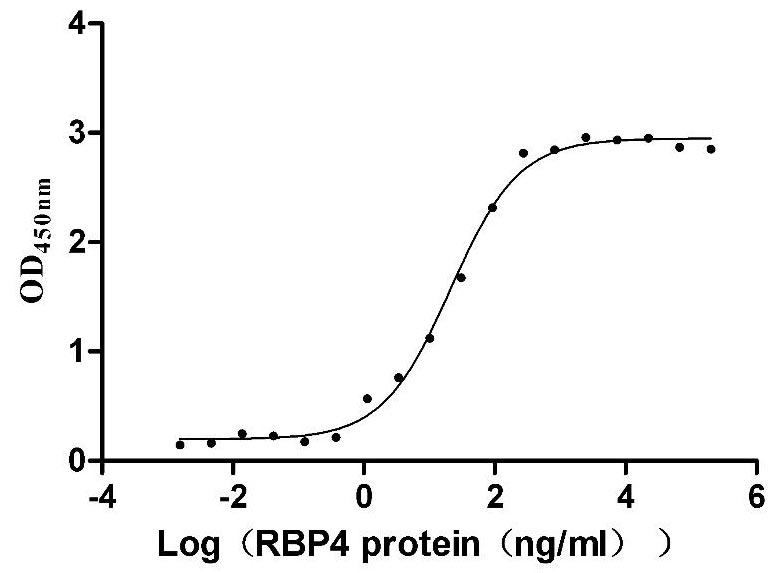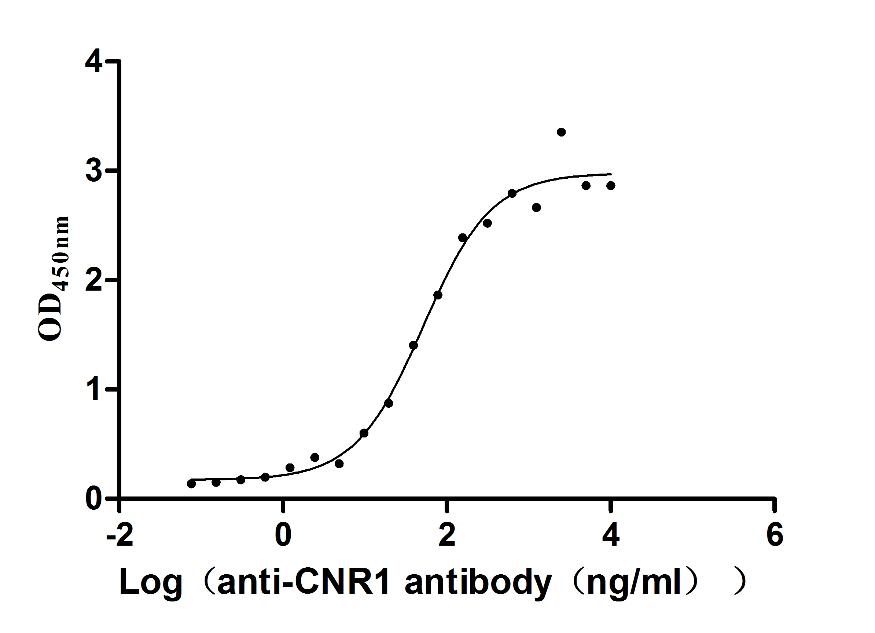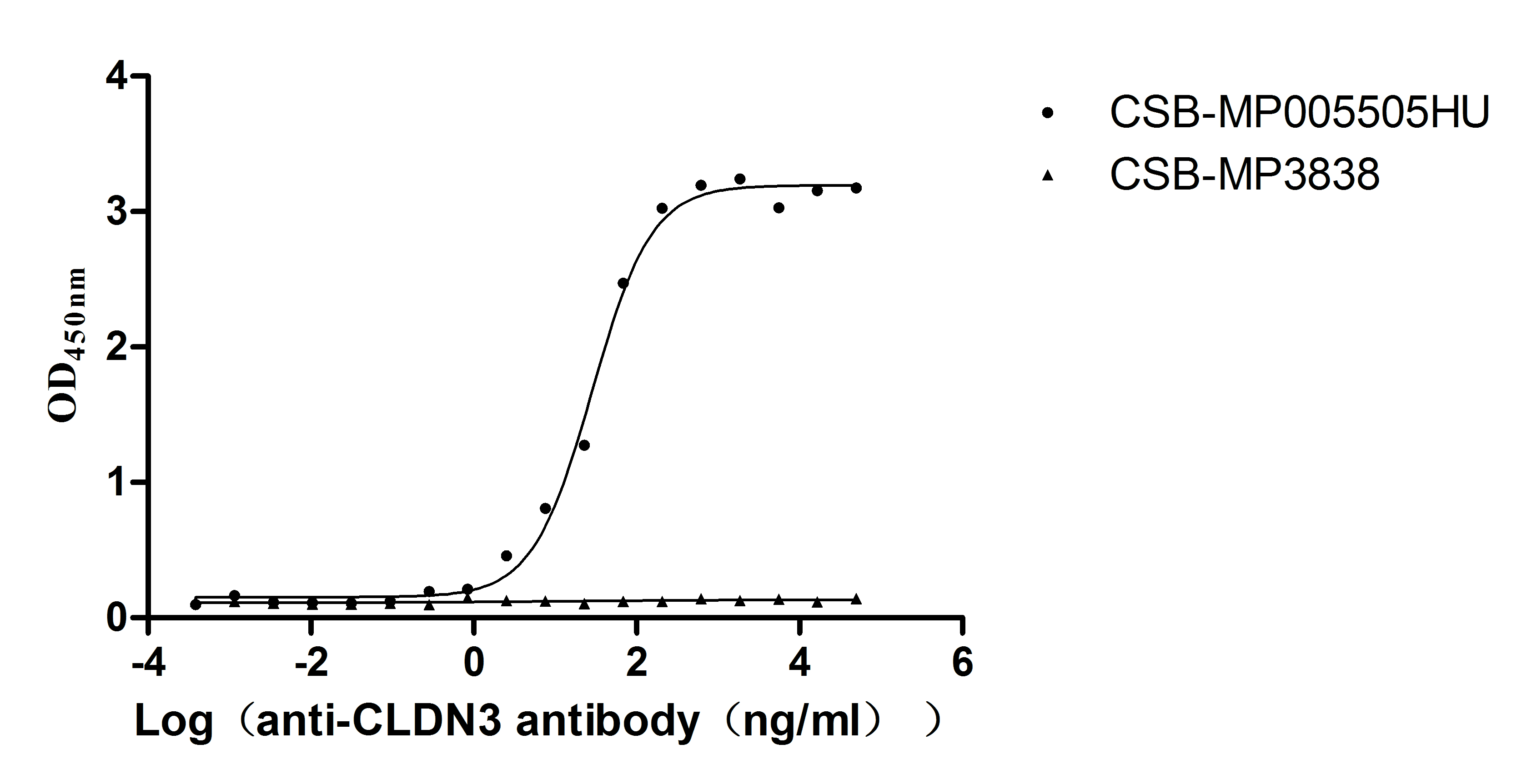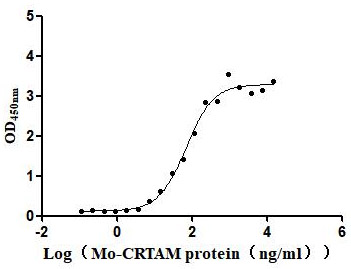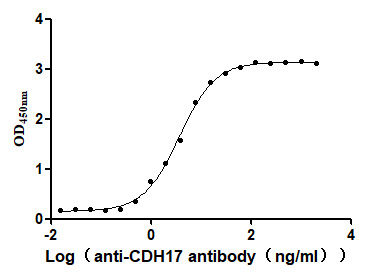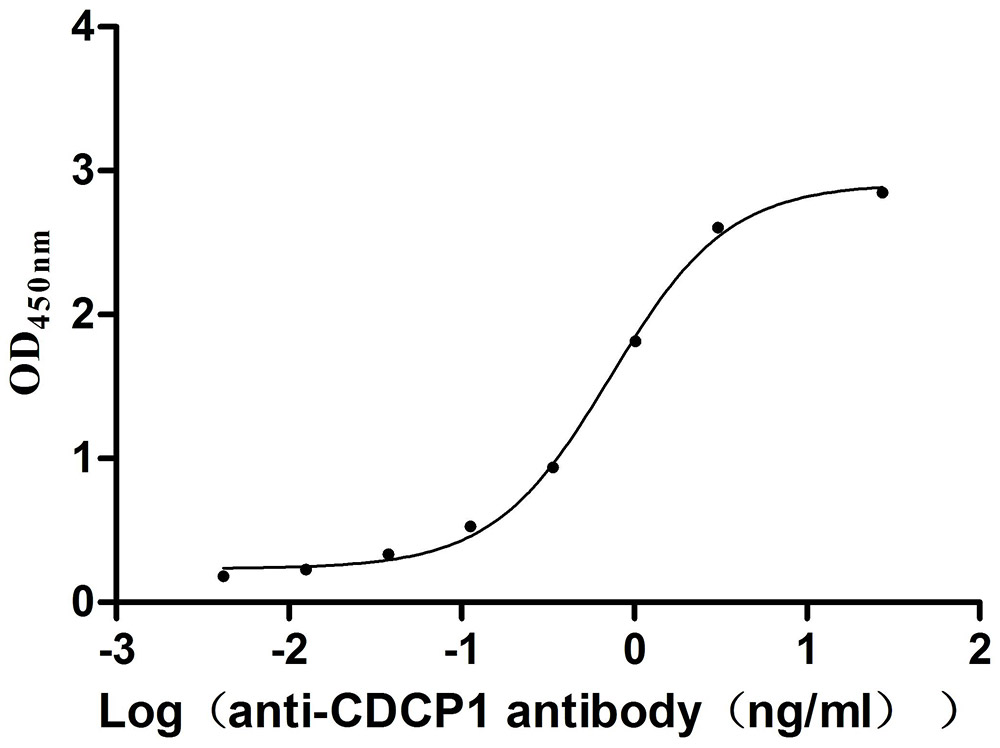Recombinant Mouse Glutamate [NMDA] receptor subunit epsilon-2 (Grin2b), partial
-
中文名稱:小鼠Grin2b重組蛋白
-
貨號:CSB-YP009913MO
-
規(guī)格:
-
來源:Yeast
-
其他:
-
中文名稱:小鼠Grin2b重組蛋白
-
貨號:CSB-EP009913MO
-
規(guī)格:
-
來源:E.coli
-
其他:
-
中文名稱:小鼠Grin2b重組蛋白
-
貨號:CSB-EP009913MO-B
-
規(guī)格:
-
來源:E.coli
-
共軛:Avi-tag Biotinylated
E. coli biotin ligase (BirA) is highly specific in covalently attaching biotin to the 15 amino acid AviTag peptide. This recombinant protein was biotinylated in vivo by AviTag-BirA technology, which method is BriA catalyzes amide linkage between the biotin and the specific lysine of the AviTag.
-
其他:
-
中文名稱:小鼠Grin2b重組蛋白
-
貨號:CSB-BP009913MO
-
規(guī)格:
-
來源:Baculovirus
-
其他:
-
中文名稱:小鼠Grin2b重組蛋白
-
貨號:CSB-MP009913MO
-
規(guī)格:
-
來源:Mammalian cell
-
其他:
產(chǎn)品詳情
-
純度:>85% (SDS-PAGE)
-
基因名:
-
Uniprot No.:
-
別名:Grin2bGlutamate receptor ionotropic; NMDA 2B; GluN2B; Glutamate [NMDA] receptor subunit epsilon-2; N-methyl D-aspartate receptor subtype 2B; NMDAR2B; NR2B
-
種屬:Mus musculus (Mouse)
-
蛋白長度:Partial
-
蛋白標(biāo)簽:Tag?type?will?be?determined?during?the?manufacturing?process.
The tag type will be determined during production process. If you have specified tag type, please tell us and we will develop the specified tag preferentially. -
產(chǎn)品提供形式:Lyophilized powder
Note: We will preferentially ship the format that we have in stock, however, if you have any special requirement for the format, please remark your requirement when placing the order, we will prepare according to your demand. -
復(fù)溶:We recommend that this vial be briefly centrifuged prior to opening to bring the contents to the bottom. Please reconstitute protein in deionized sterile water to a concentration of 0.1-1.0 mg/mL.We recommend to add 5-50% of glycerol (final concentration) and aliquot for long-term storage at -20℃/-80℃. Our default final concentration of glycerol is 50%. Customers could use it as reference.
-
儲存條件:Store at -20°C/-80°C upon receipt, aliquoting is necessary for mutiple use. Avoid repeated freeze-thaw cycles.
-
保質(zhì)期:The shelf life is related to many factors, storage state, buffer ingredients, storage temperature and the stability of the protein itself.
Generally, the shelf life of liquid form is 6 months at -20°C/-80°C. The shelf life of lyophilized form is 12 months at -20°C/-80°C. -
貨期:Delivery time may differ from different purchasing way or location, please kindly consult your local distributors for specific delivery time.Note: All of our proteins are default shipped with normal blue ice packs, if you request to ship with dry ice, please communicate with us in advance and extra fees will be charged.
-
注意事項:Repeated freezing and thawing is not recommended. Store working aliquots at 4°C for up to one week.
-
Datasheet :Please contact us to get it.
相關(guān)產(chǎn)品
靶點詳情
-
功能:Component of NMDA receptor complexes that function as heterotetrameric, ligand-gated ion channels with high calcium permeability and voltage-dependent sensitivity to magnesium. Channel activation requires binding of the neurotransmitter glutamate to the epsilon subunit, glycine binding to the zeta subunit, plus membrane depolarization to eliminate channel inhibition by Mg(2+). Sensitivity to glutamate and channel kinetics depend on the subunit composition. In concert with DAPK1 at extrasynaptic sites, acts as a central mediator for stroke damage. Its phosphorylation at Ser-1303 by DAPK1 enhances synaptic NMDA receptor channel activity inducing injurious Ca2+ influx through them, resulting in an irreversible neuronal death. Contributes to neural pattern formation in the developing brain. Plays a role in long-term depression (LTD) of hippocampus membrane currents and in synaptic plasticity.
-
基因功能參考文獻(xiàn):
- chronic KOR activation increased phosphorylation of NR2B subunit of NMDA at tyrosine 1472 (pNR2B NMDA) in the hippocampus, but not in the cortex. PMID: 27634008
- NR4A1 knockdown partly decreased surface NR2B by promoting NR2B internalization. PMID: 27876882
- Study generated the Cdkl5 KO mice, and identified hyperexcitability in response to NMDA and postsynaptic overaccumulation of GluN2B-containing NMDARs in the hippocampus. The GluN2B-selective antagonist ifenprodil abrogated the NMDA-induced hyperexcitability of Cdkl5 KO mice. These data indicate that CDKL5 plays an important role in controlling postsynaptic localization of the GluN2B-SAP102 complex in the hippocampus. PMID: 28688852
- APP intracellular domain increase in mature neurons, as reported in Alzheimer's disease, alters synaptic NMDAR composition to an immature-like GluN2B-rich profile. This disrupts synaptic signal integration, via over-activation of SK channels, and synapse plasticity. PMID: 28682239
- The induction of a conditional forebrain-specific haploinsufficiency of GluN2B in transgenic model mice reverses the pathophysiological changes in hippocampal synaptic plasticity in a mouse model of Alzheimer's disease (AD). These results provide further evidence for the involvement of the glutamatergic system in AD pathology and emphasize the GluN2B subunit as a potential target for AD treatment. PMID: 28174113
- Negative regulation of REST on NR2B in spinal cord takes part in the exacerbation of bone cancer pain. PMID: 27732941
- results demonstrated that phosphorylation level of S1284 in GluN2B was regulated by acute stress PMID: 28359951
- study are the first to demonstrate that phosphorylation of GluN2B subunit at Tyr1472 is important for trigeminal transmission of itch and suggest that the NMDA receptor activation occurs upstream of the receptor of gastrin-releasing peptide (GRP)-GRP receptor pathway PMID: 27422716
- GluN2B gene deletion mice consumed significantly less alcohol, than non-mutant controls. PMID: 28109345
- Neonatal hypoxic-ischemia reshaped the postsynaptic GluN2B interactome by recruiting new proteins, including multiple kinases, into the complexes PMID: 28993251
- PGRN decrease, resulting from pathogenic mutations, might compromise the trophism of cortical neurons by affecting GluN2B-contaning NMDA receptors PMID: 28899992
- HumanTau(AT) causes excitotoxicity mediated by NR2B-containing NMDA receptors due to enhanced extracellular glutamate. PMID: 26931569
- These in vivo changes reflect changes in glutamate transporter protein in HD mice and human HD post-mortem tissue. Furthermore, NAC was able to rescue changes in key glutamate receptor proteins related to excitotoxicity in HD, including NMDAR2B. PMID: 27179791
- Data show that hydroxyproline HyP(10) plays a critical role in maintaining the structural integrity of conantokins conRl-B, which can be correlated with its glutamate receptor, ionotropic, N-methyl D-aspartate 2B (GluN2B) subunit-selective inhibition. PMID: 27981829
- These results highlight the requirement for stringent pharmacogenetic approaches to separate specific on-target effects from nonspecific off-target effects. Importantly, they also demonstrate that the CaMKII/GluN2B interaction is required not only for normal long-term potentiation induction but also for the maintenance of synaptic strength. PMID: 27246855
- rs2284411 not associated with the need for neonatal resuscitation PMID: 27059438
- GluN2B-dependent calcium signaling and excitatory postsynaptic current, long-term depression, and spatial reversal learning are enhanced in the hippocampus of AC6(-/-) mice without altering the gross anatomy of the brain PMID: 26932446
- Unpredictable chronic mild stress mice exhibited elevated nucleus accumbens (NAC) shell levels of Glun2B. GluN2b levels were also lower within the NAC core. PMID: 25916683
- Results identify crucial determinants in the C-terminal domain of GluN2B subunits in promoting neuronal death in ischemic conditions. PMID: 26581639
- The results suggest that NR2B vulnerability represents a target for environmental toxicants in the brain. PMID: 26901155
- Results show that monomeric Abeta1-42 application induces an increase of the Ca2+-response and of the membrane expression of the extrasynaptic subunit of the NMDA receptor GluN2B in PC12 cells, while the opposite effects were observed in cultured neurons PMID: 26401567
- Results demonstrate that up-regulation of NR2B expression facilitates acquisition of auditory cued fear memory and enhances long-term potentiation at thalamus-lateral amygdala synapses PMID: 26118841
- Loss of GluN2B in principal neurons of the forebrain results in reduced punished food reward-seeking. PMID: 26223494
- Study demonstrated that the GluN2B carboxy-terminal domain is necessary for enhanced social recognition memory in GluN2B transgenic overexpression mice PMID: 26179233
- Visual plasticity in adult mice was dramatically enhanced following magnesium treatment, which was concurrent with an increase in the expression of NR2 subunits of N-methyl-D-aspartate receptors. PMID: 26282667
- Results support the role of N-methyl-D-aspartate receptor, and GluN2B, on modulation of striatal function necessary for efficient choice behavior and suggest that NMDAR on interneurons may play a critical role in associative learning. PMID: 25968910
- Study suggests that NMDA receptor NR2B subunits contribute to epilepsy-associated pathological and biochemical events, including hippocampal astrocytosis, oxidative stress and neuron loss, and these events might be correlated with BDNF up-regulation PMID: 25896886
- Study provides further evidence of antidepressant-like activity of GluN2B antagonism and offers novel insight into the glutamate receptor subunits, interacting molecules and brain regions mediating these effects PMID: 25800971
- results revealed that the phosphorylation change of GluN2B at Tyr-1070 accompanied the Tyr-1472 phosphorylation and Fyn associated with GluN2B in synaptic plasticity induced by both chemical and contextual fear learning. PMID: 26229100
- Corticohippocampal loss of GluN2B selectively impaired an initial reversal in a stimulus specific manner and impaired the ability of mutant mice to form an attentional set. PMID: 25798630
- GluN2B accumulates in endoplasmic reticulum-enriched synaptic fractions in AIDA-1 knock-out mice. PMID: 26085624
- study suggested that a chronic increase of NMDARs activation by NR2B overexpression in the forebrain may enhance the protein serine/threonine phosphorylation levels of MAPK/ERK-CREB and thereby regulated their signaling pathway PMID: 25128602
- GluN1 amino-terminal domain adopts a more open conformation when coassembled with GluN2A than with GluN2B. PMID: 25829490
- findings indicated that CaMKII-mediated KIF17/NR2B trafficking may contribute to bone cancer pain, and inhibition of CaMKII may be a useful alternative or adjunct therapy for relieving cancer pain PMID: 24836181
- Chronic neuropathic pain was found to be modulated via regulation of NR2B. PMID: 25568101
- Upregulation of NR2B phosphorylation at Y1472 after neonatal hypoxia-ischemia is involved in superoxide-mediated oxidative stress and contributes to brain injury. PMID: 25158771
- The expression of the GluN2B subunit was increased in hippocampus following enhanced synaptic transmission by simvastatin. PMID: 24687455
- GluN2B-containing NMDARs keep the hippocampal circuit activity under control by promoting the maturation of excitatory synapses in interneurons. PMID: 25429143
- Gentiopicroside downregulates GluN2B receptors, but not GluN2A receptors, in the amygdala of rats with reserpine-induced pain. PMID: 24584520
- GluN2B expressed at glutamatergic synapses on glutamatergic projection neurons facilitates refinement of ascending pathway synapses directly PMID: 25164652
- Neural activity of newborn neurons is regulated by their own NR2B-containing NMDA glutamate receptors. PMID: 23904361
- Knockdown of GluN2B in the bed nucleus of stria terminalis decreased the latency to consume food in novelty-induced hypophagia, a surrogate marker of affective state. PMID: 24301649
- Disrupting NR2B-Cdk5 interaction via a small interfering peptide (siP) increases NR2B surface levels, facilitates synaptic transmission, and improves memory formation in vivo. PMID: 24607229
- the PS1/gamma-secretase system regulates release of glutamate, tyrosine phosphorylation, and surface expression of GluN2B-containing NMDARs. PMID: 24025330
- elevated intraocular pressure-induced increase in expression of NR2B subunits of NMDARs may be involved in retinal ganglion cell degeneration of DBA/2J mice. PMID: 24175101
- the increase in the amount of NMDARs required phosphorylation of the NMDAR subunit GluN2B at Tyr(1472) by a pathway involving adenylyl cyclase subtype 1 (AC1), protein kinase A (PKA), and Src family kinases. PMID: 23674822
- GluN2B- and GluN2D-containing NMDA receptors play a critical role in N-methyl-D-aspartate-induced excitotoxic retinal cell death. PMID: 23902942
- Inhibition of NR2B-containing NMDARs abolished Abeta-induced hTau phosphorylation and toxicity by preventing GSK-3beta activation but did not affect dendritic spine loss. PMID: 23618906
- An increased association of GluN2B-containing NMDA receptors with synaptic scaffolding proteins in aged animals may have contributed to the age-related memory declines. PMID: 23884936
- Corticostriatal or striatal deletion of Grin2b or dorsal-striatum-restricted GluN2B antagonism impaired choice learning. Cortical Grin2b deletion or orbitofrontal GluN2B antagonism impaired shifting. PMID: 23831965
顯示更多
收起更多
-
亞細(xì)胞定位:Cell membrane; Multi-pass membrane protein. Cell junction, synapse, postsynaptic cell membrane; Multi-pass membrane protein. Late endosome. Lysosome. Cytoplasm, cytoskeleton.
-
蛋白家族:Glutamate-gated ion channel (TC 1.A.10.1) family, NR2B/GRIN2B subfamily
-
組織特異性:Detected in brain (at protein level). Detected throughout the brain, and in brain stem trigeminal nucleus. Detected in forebrain.
-
數(shù)據(jù)庫鏈接:
Most popular with customers
-
Recombinant Mouse Transthyretin (Ttr) (Active)
Express system: Mammalian cell
Species: Mus musculus (Mouse)
-
Recombinant Human Cannabinoid receptor 1 (CNR1)-VLPs (Active)
Express system: Mammalian cell
Species: Homo sapiens (Human)
-
Recombinant Human Claudin-3 (CLDN3)-VLPs (Active)
Express system: Mammalian cell
Species: Homo sapiens (Human)
-
Recombinant Mouse Cell adhesion molecule 1 (Cadm1), partial (Active)
Express system: Mammalian cell
Species: Mus musculus (Mouse)
-
Recombinant Human Cadherin-17 (CDH17), partial (Active)
Express system: Mammalian cell
Species: Homo sapiens (Human)
-
Recombinant Mouse CUB domain-containing protein 1 (Cdcp1), partial (Active)
Express system: Mammalian cell
Species: Mus musculus (Mouse)
-
Recombinant Human Transmembrane 4 L6 family member 1(TM4SF1)-VLPs (Active)
Express system: Mammalian cell
Species: Homo sapiens (Human)
-
Recombinant Human Cadherin-1(CDH1),partial (Active)
Express system: Mammalian cell
Species: Homo sapiens (Human)


